|
|
|
[Homebase]
[Gallery] |
[Festival]
[International Press] |
[International Tours] |
| German Press | Swedish Press |
| French Press | Dutch Press |
| Tour Press | English Press |
| Press in English |
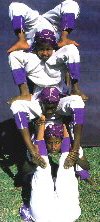 And
it is from these rigid columns that the boys and girls begin their warm-up
routines, swinging and twirling from the gymnastic rings, each time more
rapidly and with greater skill, ending the sessions by jumping off, softly
on both feet, without losing their balance. All around them equipment needed
for other routines wait stacked neatly along the entire perimeter of the
room. On the left side of the room is the small stage used for juggling
routines. On the right, the trampoline and uni-cycle wait for the young
atheletes, who take turns mounting it.
And
it is from these rigid columns that the boys and girls begin their warm-up
routines, swinging and twirling from the gymnastic rings, each time more
rapidly and with greater skill, ending the sessions by jumping off, softly
on both feet, without losing their balance. All around them equipment needed
for other routines wait stacked neatly along the entire perimeter of the
room. On the left side of the room is the small stage used for juggling
routines. On the right, the trampoline and uni-cycle wait for the young
atheletes, who take turns mounting it.
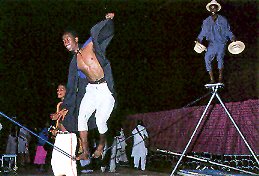 «I
always met children in the street asking for money. But I was not interested
in giving money to them" said Marc La Chance, who works by day at the International
Community School. Rather, 1 thought, why not organize them into a constructive
project. "Circus Ethiopia, begun with ten Felasha children trying to juggle
3 balls» has grown to 40 children with expanded rou tines. Today
they juggle fire not just balls, and the older children balance smaller
ones on top of long poles. They pride themselves in doing most anything
expected of a professional troupe, from tight rope walking to sophisticated
acrobatics.
«I
always met children in the street asking for money. But I was not interested
in giving money to them" said Marc La Chance, who works by day at the International
Community School. Rather, 1 thought, why not organize them into a constructive
project. "Circus Ethiopia, begun with ten Felasha children trying to juggle
3 balls» has grown to 40 children with expanded rou tines. Today
they juggle fire not just balls, and the older children balance smaller
ones on top of long poles. They pride themselves in doing most anything
expected of a professional troupe, from tight rope walking to sophisticated
acrobatics.
"In our country no attempt is made to entertain children. Circus Ethiopia
entertains them and lets them know what a circus is" said the head trainer,
Yared Eshetu.
"Besides, it makes our performers think about being organized. It makes
them think about the importance of doing something worth while for themselves
and for Ethiopia" Yared said.
The circus gives the performers individual skill in gymnastics and
as an added benefit it introduces circus acts to the country, with no tradition
is thés entertainment form. Many Ethiopians think that a circus
is something that can only happen abroad. "So it was unbelievable, for
many people, to see Ethiopian kids juggling, passing fire, and doing knife
routines" Yared said.
For children like Enguday Bekele, 14, originally from Jimma, gymnastics
has become more than just a way to stay slim. "It makes me feel free and
happy". Getting to the circus is not an obstacle no matterhow far it is
from home. The star performer of the circus, Abiy Hailemariam, 17, travers
everyday from Asko Medhanealem. "I can do it," he said, "the travel and
the most difficult routines."
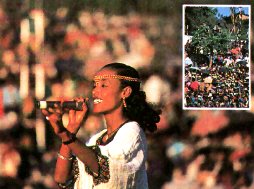 The
evening began with presentations to members of ERCS. Then followed short
speeches by the Dep. Head and Head of ICRC and the First Secretary of the
Swedish Embassy which sponsored the event.
The
evening began with presentations to members of ERCS. Then followed short
speeches by the Dep. Head and Head of ICRC and the First Secretary of the
Swedish Embassy which sponsored the event.
The founder and director of Circus Ethiopia, Mr. Marc Lachance, gave
a more detailed perspective to the purpose of the group. He recailed that
in 1991 , while cycling to and from his job as a teacher, he encountered
street kids and beggars close up, ("you can't roll your window up on a
bicycle"). He decided not to give a salary for begging but to do something
more permanent. So, with a car stereo and 700 juggling, tightrope-walking
and acrobatic children, Circus Ethiopia was born.
The performance, "Shoe Shiner", is really about all the aspects
of being on the street. Hunger, cold, loneliness, violence, rape
and death were all confronted by Abate Mekuria, playwright, music and direction.
The evening swang from dazzling displays of acrobatics and other circus
acts to poignant dance pieces which portrayed the harsh reality of the
theme of the play. The "Shoe Shiner" is the result of 3 months work and
this group have performed over 200 times in the last four years including
a tour in HoIland where they were shown on television to an audience of
over one million people. They are now embarking on a 35-date tour all round
the country.
The circus worked in collaboration with "Theatre in Development," a
project which endeavors to nurture artistic expression and self-esteem
among disadvantaged children. This, coupled with the Red Cross' continuing
commitment to "meet the needs of the most vulnerable," made this a truly
world-class evening.
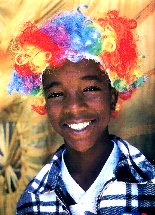 At
the end of a rough road up a hill on the edge of Addis Ababa, surrounded
by a fence made of corrugated-métal sheets, are the administrative
offices of Circus in Ethiopia, recently relocated from La Chance's house.
I let myself in through the sheet-meta1 gate by slipping a looped string
off a nail. Behind a small grass hut is a one-room cookhoust with a long
washing stand and water taps in front. I meet Sister, a friendly middle
aged woman who is in charge of the kitchen, supplies and buying food for
hundreds of meals each week. She is also the one the children go to with
any minor medical problems. Next to the cookhouse is a small four-room
office made of straw, mud, and concrete and barely covered with faded yellow
paint. It is afternoon, and more than a dozen children are inside in the
largest roam, sitting at three tables and doing homework, guided by tutor
hired by the circus. In the next room are boxes, suitcases, and racks of
costumes. In two other smaller rooms, people are busy typing information
into three computers. One of the typists is Socina Tewabe, I8, a
three-year veteran of thc circus. She has fiery eyes and feline features.
"The circus is my dream come true," - she says. "It's my life and family.
If I do not continue as a professional circus artist, then I would
like to be a trainer or help with the circus in soma other - way." All
members of the main troupe are unpaid, but they are fed at the compound
and receive money (less than one pound) to cover their transportation cost
to mandatory training sessions every afternoon, including Sundays, when
regular free performances are held. Students of the circus school pay 1,5
pound a month tuition. Outside the gate and farther up the hill, next to
an open field with grazing cows and goats, is a gymnasium-sized training
hall that the circus rents.
At
the end of a rough road up a hill on the edge of Addis Ababa, surrounded
by a fence made of corrugated-métal sheets, are the administrative
offices of Circus in Ethiopia, recently relocated from La Chance's house.
I let myself in through the sheet-meta1 gate by slipping a looped string
off a nail. Behind a small grass hut is a one-room cookhoust with a long
washing stand and water taps in front. I meet Sister, a friendly middle
aged woman who is in charge of the kitchen, supplies and buying food for
hundreds of meals each week. She is also the one the children go to with
any minor medical problems. Next to the cookhouse is a small four-room
office made of straw, mud, and concrete and barely covered with faded yellow
paint. It is afternoon, and more than a dozen children are inside in the
largest roam, sitting at three tables and doing homework, guided by tutor
hired by the circus. In the next room are boxes, suitcases, and racks of
costumes. In two other smaller rooms, people are busy typing information
into three computers. One of the typists is Socina Tewabe, I8, a
three-year veteran of thc circus. She has fiery eyes and feline features.
"The circus is my dream come true," - she says. "It's my life and family.
If I do not continue as a professional circus artist, then I would
like to be a trainer or help with the circus in soma other - way." All
members of the main troupe are unpaid, but they are fed at the compound
and receive money (less than one pound) to cover their transportation cost
to mandatory training sessions every afternoon, including Sundays, when
regular free performances are held. Students of the circus school pay 1,5
pound a month tuition. Outside the gate and farther up the hill, next to
an open field with grazing cows and goats, is a gymnasium-sized training
hall that the circus rents.
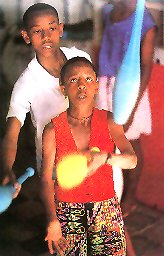 Approaching
the building I can pick up the sliding quarter notes of Ethiopian music
and loud African percussion. Inside at one end is the bandstand stacked
with speakers, cords, and sound equipment. The band has a musical director,
keyboard player, drummer, four singers, and four musicians who play traditional
Ethiopian stringed instrument, including a misinko, which has a single
string and is played with a bow. A young musician shows me his makeshift
imtrument, made from a tin can that he played on the street before coming
to the circus. On one wall hang half e dozen unicycles; nearby are boxes
of ropes, juggling pins and balls, and other circus gear. On another are
pinned scores of photographs, newspaper clippings, and magazine stories
recounting Circus in Ethiopia's success To speak of Ethiopia and success
in one breath may seem odd to westerners, but the fact is that I can see
only hope and pride in in the eyes of the young circus performers.
Approaching
the building I can pick up the sliding quarter notes of Ethiopian music
and loud African percussion. Inside at one end is the bandstand stacked
with speakers, cords, and sound equipment. The band has a musical director,
keyboard player, drummer, four singers, and four musicians who play traditional
Ethiopian stringed instrument, including a misinko, which has a single
string and is played with a bow. A young musician shows me his makeshift
imtrument, made from a tin can that he played on the street before coming
to the circus. On one wall hang half e dozen unicycles; nearby are boxes
of ropes, juggling pins and balls, and other circus gear. On another are
pinned scores of photographs, newspaper clippings, and magazine stories
recounting Circus in Ethiopia's success To speak of Ethiopia and success
in one breath may seem odd to westerners, but the fact is that I can see
only hope and pride in in the eyes of the young circus performers.
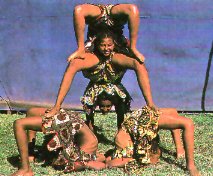 When
Marc La Chance, the Director General and Founder of Circus in Ethiopia,
arrived in Addis Ababa from Canada in 1990 to teach at the International
Community School, he had no idea that he was about to initiate a unique
cultural event. Yet seven years later he finds himself heading a non-profit
organization that has spread its roots throughout the length and breadth
of Ethiopia. It has inspired hundreds of children in an explosion of creativity
that has surpassed his wildest dreams.
When
Marc La Chance, the Director General and Founder of Circus in Ethiopia,
arrived in Addis Ababa from Canada in 1990 to teach at the International
Community School, he had no idea that he was about to initiate a unique
cultural event. Yet seven years later he finds himself heading a non-profit
organization that has spread its roots throughout the length and breadth
of Ethiopia. It has inspired hundreds of children in an explosion of creativity
that has surpassed his wildest dreams.
By teaching a few children to juggle stones in his neighbourhood, Marc
sowed the seeds of an idea of the circus. The concept has spread with suche
nthusiasm that there are now six circuses from different parts of the country,
each with its own unique identity. From small beginnings the idea of a
circus has evolved into a pyramid of activity. The circus has tapped sources
of creativity and developed skills in Ethiopia's children. For these children
self-expression is a new concept, and a luxury in a country recovering
from years of war and famine.
In other words the circus in Ethiopia is a small African marvel that
has become a big topic of discussion. In the con text of Ethiopia, the
circus has come to mean far more than its European counterpart - which
is a traditional side-show of animal trainers, clowns and high-wire acts.
In Ethiopia it is an event whose implications are fareaching.